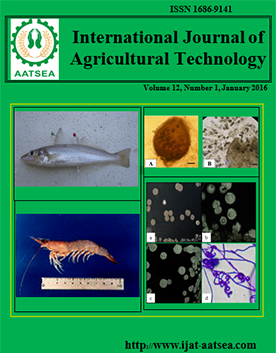Assessment a new pollen supplement diet for honey bee colonies and their effects on some biological activities
Main Article Content
Abstract
Article Details

This work is licensed under a Creative Commons Attribution-NonCommercial-NoDerivatives 4.0 International License.
References
Abdellatif, M. A., El-Gaisar, F. H. and Mohanna, N. M. (1971). Three forms of yeast as a pollen substitute. American Bee Journal 111:14-15.
Allen, M. D. and Jeffree, E. P. (1956). The influence of stored pollen and of colony size on the brood rearing of honey bees. Annals of Applied Biology 44:649 -656.
Chhuneja, P. K., Brar, H. S. and Goyal, N. P. (1992). Studies on some pollen substitutes fed as moist-patty to Apis mellifera L. colonies 1. preparation and consumption. Indian Bee Journal 55:17-25.
DeGrandi-Hoffman, G., Wardell, G., Ahumada-Segura, F., Rinderer, T., Danka, R. and Pettis, J. (2008). Comparisons of pollen substitute diets for honey bees: consumption rates by colonies and effects on brood and adult populations. Journal of Apicultural Research and Bee World 47:265-270.
DeGroot, A. P. (1953). Protein and amino acid requirements of the honey bee (Apis mellifero L.). Physiologia Comparata et d'Ecogia 3:195-285.
Dodologlu, A., Dulger, C. and Genc, F. (2004). Colony condition and bee behaviour in honey bees (Apis mellifera L.) housed in wooden or polystyrene hives and bee cake or syrup. Journal of Apicultural Research 43:3-8.
Doull, K. M. (1973). Relationship between pollen, brood rearing and consumption of pollen supplements by honey bees. Apidologie 4:285-293.
Fresnay, J. (1962). A new instrument for brood measurement in a honey bee colony. American Bee Journal 111:20-21.
Hellmich, R. L. and Rothenbuhler, W. C. (1986). Relationship between different amounts of brood and the collection and use of pollen by the honey bee (Apis mellifera L.). Apidologie 17:13-20.
Kumar, J. Srivastava, S. and kashyap, N. P. (1995). Effect of strength of worker bees on honey bee production in Apis mellifera colonies. Indian Bee Journal 57:174-176.
Manning, R. (2001). Fatty acids in pollen: a review of their importance to honeybees. Bee World 82:60-75.
Matilla, H. R. and Otis, G. W. (2006). Influence of pollen diet in spring on the development of the honey bee (Hymenoptera: Apidae) colonies. Journal of Economic Entomology 99:604-613.
Nabors, R. (2000). The effects of spring feeding pollen substitute to colonies of Apis mellifera. The American Bee Journal 140:322-323.
Rashid, M., Wagchoure, E. S., Mohsin, A. U., Raja, S. and Sarwar, G. (2012). Control of ectoparasitic mites in honeybee (Apis mellifera L.) colonies by using thymol and oxalic acid. Pakistan Journal Zoology 44:985-989.
Saffari, A. M., Kevan, P. G. and Atkinson, J. L. (2004). A promising pollen substitute for honey bees. American Bee Journal 144:230-231.
Saffari, A. M., Kevan, P. G. and Atkinson, J. K. (2006). Feedbee balances growth feeding colnies with a nutritious pollen supplement is beneficial. Bee culture 134:30-31.
Skubida, P., Semkiw P. and Pohorecka, K. (2008). Simulative feeding of bees as one factor in preparing colonies for early nectar flows. Journal of Apicultural Science 52:65-72.
Standifer, L. N., Owens, C. D., Mills, J. P. and Levin, M. D. (1973). Supplementary feeding of honey bee colonies in Arizona. American Bee Journal 113:298-301.
Zahra, A. and Talal, M. (2008). Impact of pollen supplements and vitamins on the development of hypopharyngeal glands and brood area in honey bees. Journal of Apicultural Science 52:5-12.


